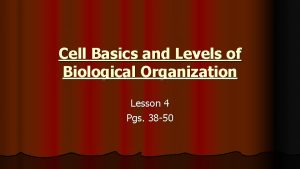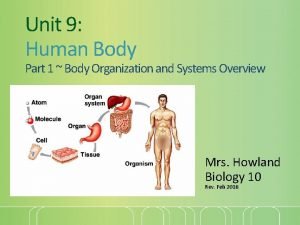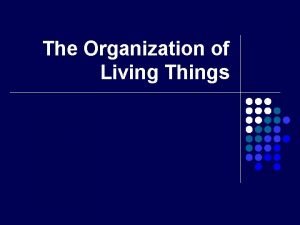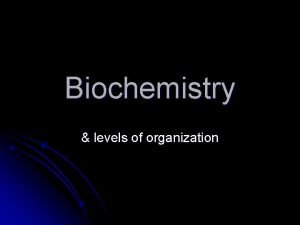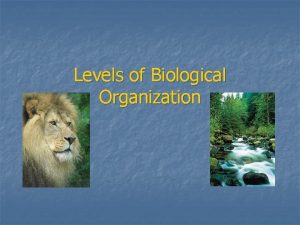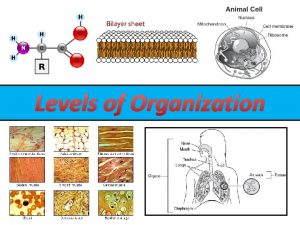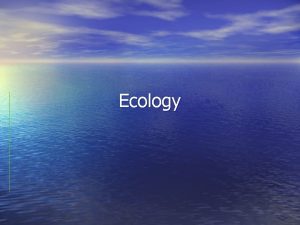Introduction to Physiology and Levels of Organization Red









- Slides: 9

Introduction to Physiology and Levels of Organization Red: very important. Green: only found in males’ slides. Purple: only found in females’ slides. Gray: notes. Physiology Team 436 – Foundation block lecture 1 1 Lecture: If work is intended for initial studying. Review: If work is intended for revision.

Objectives o Define Physiology. o Understand Physiology’s types o Describe the levels of organization of an organism 2

Definition Physio + logy Ø Physio : nature Ø Logy : science or study of Physiology : The science dealing with the way a normal organism and their body parts function , and how these functions are maintained in a changing environment. ( Considered as one of the cornerstones of medicine ) 3

Types of Physiology Cellular physiology � is the study of the cellular components that primarily determines organ function. 4 Systems physiology � is the study of the coordinated and networked processes that determine whole body function and adaption to change.

Definition Anatomy and Physiology Histology Biochemistry/Chemistr y Chemistry 5 Cells may differ markedly from one another, but they all share certain basic characteristics.

The Internal Environment “Milieu Intérieur” (ECF) � All the cells in the body are continuously bathing in fluid. � Because this fluid is outside extracellular fluid (ECF). the cell, it is called � It is from the ECF that cells get the ions and nutrients needed to maintain life. � All cells in the body live in the same environment i. e. ECF. 6 (Guyton and Hall Textbook of Medical Physiology. 13 th ed. Ch-1)

Extracellular Fluid → it was called the internal environment (milieu interieur) by the French physiologist Claude Bernard. 7 ste wa 2. The composition of ECF is almost similar between the different species. nu trie 1. All body cells live in the same environment i. e. ECF. nts Cells receive ions, nutrients and oxygen needed to maintain life from ECF. Because this fluid is outside the cells it is called “extracellular fluid (ECF)” (Guyton and Hall Textbook of Medical Physiology. 13 th ed. Ch-1)

Important info. � Fluid body compartments are divided into: �– Intracellular �– Extracellular � The amount of solutes in the two compartments differ. (3 rd Lecture) � How is this achieved and maintained? “Selective permeability” (2 nd Lecture) 8

Thank you!. ﻋﻤﻼ ﺃﺤﺴﻦ ﻣﻦ ﺃﺠﺮ ﻳﻀﻴﻊ ﻻ ﺍﻟﻠﻪ ﺃﻦ ﺗﻌﻠﻢ ﺃﻨﺖ ﻭ ﺍﻋﻤﻞ ، ﺩﻣﻌﺔ ﻟﺘﻤﺴﺢ ﺍﻋﻤﻞ ، ﺑﺴﻤﺔ ﻟﺘﺮﺳﻢ ﺍﻋﻤﻞ The Physiology 436 Team: Lina Alwakeel Fahad Al Fayez Ibrahim Al Deeri Dina Aldossary Hassan Al Shammari Rana Barassain Abdullah Al Otaibi Heba Alnasser Abdullah Al Subhi Munira Aldofayan Ali Al Subaei Sara Alshamrani Omar Al Babteen Sundus Alhawamda Foad Fathi Faisal Al Fawaz Ruba Ali Muhammad Al Rehab Alanazi Aayed Norah Alshabib Muhammad Al Mutlaq Nasser Abu Dujeen Nouf Alaqeeli Waleed Al Asqah Buthaina Almajed 9 Team Leaders: Qaiss Almuhaideb Lulwah Alshiha Contact us: Physiology 436@gmail. com @Physiology 436
 The blood anatomy and physiology
The blood anatomy and physiology Functional organization physiology
Functional organization physiology Chapter 1 introduction to human anatomy and physiology
Chapter 1 introduction to human anatomy and physiology Anterior posterior distal proximal
Anterior posterior distal proximal Cephalic cranial
Cephalic cranial Levels of biological organization
Levels of biological organization Level 2 costa questions examples
Level 2 costa questions examples Point by point arrangement
Point by point arrangement Body organization
Body organization Organization of living things
Organization of living things





